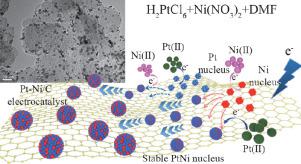Chinese Journal of Catalysis ( IF 15.7 ) Pub Date : 2021-08-30 , DOI: 10.1016/s1872-2067(21)63860-3 Lutian Zhao 1 , Yangge Guo 1 , Cehuang Fu 1 , Liuxuan Luo 1 , Guanghua Wei 2 , Shuiyun Shen 1 , Junliang Zhang 1

|
In this work, highly monodispersed Pt-Ni alloy nanoparticles were directly deposited on carbon substrate through a facile electrodeposition strategy in the solvent system of N,N-dimethylformamide (DMF). A series of carbon supported Pt-Ni alloy electrocatalysts were synthesized under different applied electrode potentials. Among all as-obtained samples, the Pt-Ni/C electrocatalyst deposited at –1.73 V exhibits the optimal specific activity up to 1.850 mA cm−2 at 0.9 V vs. RHE, which is 6.85 times higher than that of the commercial Pt/C. Comprehensive physiochemical characterizations and computational evaluations via density functional theory were conducted to unveil the nucleation and growth mechanism of PtNi alloy formation. Compared to the aqueous solution, DMF solvent molecule must not be neglected in avoiding particle agglomeration and synthesis of monodispersed nanoparticles. During the alloy co-deposition process, Ni sites produced through the reduction of Ni(II) precursor not only facilitates Pt-Ni alloy crystal nucleation but also in favor of further Pt reduction on the Ni-inserted Pt surface. As for the deposition potential, it adjusts the final particle size. This work provides a hopeful extended Pt-based catalyst layer production strategy for proton exchange membrane fuel cells and a new idea for the nucleation and growth mechanism exploration for electrodeposited Pt alloy.
中文翻译:

电沉积 PtNi 纳米粒子对氧还原反应:成核和生长机制的研究
在这项工作中,高度单分散的 Pt-Ni 合金纳米粒子通过在N,N-二甲基甲酰胺 (DMF)溶剂系统中的简便电沉积策略直接沉积在碳基底上。在不同的电极电位下合成了一系列碳负载的 Pt-Ni 合金电催化剂。在所有获得的样品中,在 –1.73 V 下沉积的 Pt-Ni/C 电催化剂在 0.9 V vs 0.850 mA cm -2下表现出最佳比活性。RHE,比商业 Pt/C 高 6.85 倍。综合理化表征和计算评估通过密度泛函理论揭示了PtNi合金形成的成核和生长机制。与水溶液相比,DMF 溶剂分子在避免颗粒团聚和合成单分散纳米颗粒方面不容忽视。在合金共沉积过程中,通过还原 Ni(II) 前驱体产生的 Ni 位点不仅有利于 Pt-Ni 合金晶体的成核,而且有利于进一步在 Ni 插入的 Pt 表面上还原 Pt。至于沉积电位,它会调整最终的粒径。这项工作为质子交换膜燃料电池提供了一种有希望的扩展 Pt 基催化剂层生产策略,并为电沉积 Pt 合金的成核和生长机制探索提供了新思路。











































 京公网安备 11010802027423号
京公网安备 11010802027423号